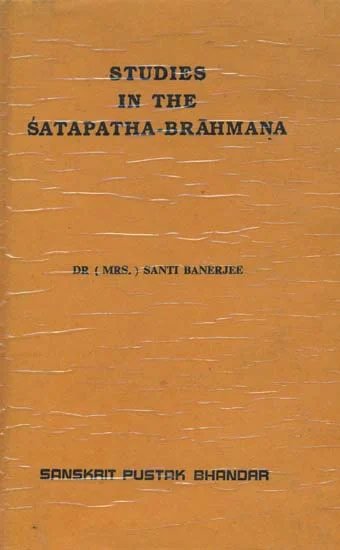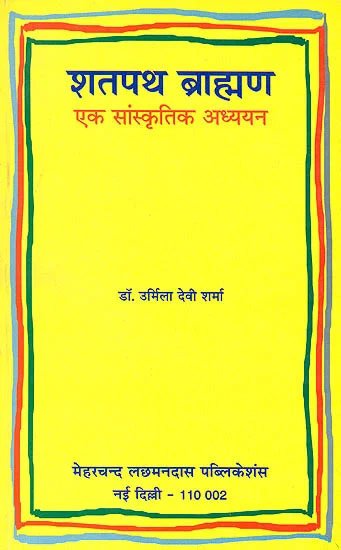Satapatha-brahmana [sanskrit]
147,532 words | ISBN-10: 812080113X | ISBN-13: 9788120801134
The Sanskrit text of the Satapatha-brahmana: One of the largest works in the category of Vedic (Brahmaic) literature, narrating in extensive detail the various rites, constructions, chants and utensils to be used in Hindu ceremonies. Alternative titles: Śatapathabrāhmaṇa (शतपथब्राह्मण), Śatapatha-brāhmaṇa (शतपथ-ब्राह्मण) Shatapathabrahma (shatapatha).
Verse 8.2.2.8
sajūrṛtubhiriti | tadṛtūnprājanayadṛtubhirvai sayugbhūtvā prājanayatsajūrvidhābhirityāpo vai vidhā adbhirhīdaṃ sarvaṃ vihitamadbhirvai sayugbhūtvā prājanayatsajūrdevairiti taddevānprājanayadyaddevā ityācakṣate sajūrdevairvayonādhairiti prāṇā vai devā vayonādhāḥ prāṇairhīdaṃ sarvaṃ vayunaṃ naddhamatho candāṃsi vai devā vayonādhāścandobhirhīdaṃ sarvaṃ vayunaṃ naddham prāṇairvai sayugbhūtvā prājanayadagnaye tvā vaiśvānarāyeti saṃvatsaro vā agnirvaiśvānaraḥ saṃvatsareṇa vai sayugbhūtvā prājanayadaśvinādhvaryū sādayatāmiha tvetyaśvibhyāṃ vai sayugbhūtvā prājanayat
Preview of English translation:
8. [He lays down the Vaishvadevi bricks, with Vajasaneyi Samhita XIV, 7], “In union with the seasons,”—he thereby produced the seasons, and having entered into union with the seasons he produced (creatures);—“in union with the ranges,”—the ranges, doubtless, are the waters, for by water everything is ranged (distributed or produced) here: having entered into union with the waters he produced (creatures);—“in union with the gods,”—he thereby produced the gods,—those who are called 'gods;'—“in union with the life-sustaining gods,”—the life-sustaining gods, doubtless, are the vital airs, for by the vital airs everything living here is sustained; or, the life-sustaining gods are the metres, for by the metres (sacred writ) everything living is sustained here; having entered into union with the vital airs he produced creatures;- 'for Agni Vaishvanara,'—Agni Vaishvanara [“belonging to all men”], doubtless, is the year: having entered into union with the year he produced creatures;—“May the Ashvins, the Adhvaryus, settle thee here!”—having entered into union with the Ashvins he produced creatures.
For a detailled translation, including proper diacritics and footnotes, go the full English translation.
Other editions:
Also see the following editions of the Sanskrit text or (alternative) English translations of the Satapatha-brahmana Verse 8.2.2.8
The Satapatha Brahmana (In Five Volumes)
by Julius Eggeling (1882)
2551 pages; [Publisher: Motilal Banarsidass Publishers Pvt. Ltd.]
Buy now!
The Satapatha Brahmana (3 volumes)
by Dr Jeet Ram Bhatt (2009)
Sanskrit Text with English Translation; 1726 pages; [Publisher: Eastern Book Linkers]; ISBN: 9788178541693
Buy now!
The Satapatha Brahmana (With The Commentary of Sayanacarya and Harisvamin)
by Rashtriya Sanskrit Sansthan (2002)
3483 pages; [शतपथ ब्राह्मणम्] According to the Madhyandina Recension; Commetaries: (1) Vedarthaprakash (Vedartha-prakasha) by Shrimat-Trayibhashyakar Sayanacharya, (2) Sarvavidyanidhana Kavindracharya Saraswati.
Buy now!
Studies in the Satapatha-Brahmana
by Dr. (Mrs.) Santi Banerjee (1993)
236 pages; [Publisher: Sanskrit Pustak Bhandar]
Buy now!
Cultural Study of the Satapatha Brahman (in Hindi)
by Dr. Urmila Devi Sharma (1982)
106 pages; Shatapatha Brahmana Ek Sanskritik Adhyan; [Publisher: Meharchand Lakshmandas Publications]
Buy now!![Satapatha-brahmana [sanskrit] - book cover](/uploads/a/NAC457-Satapatha-Brahmana.jpg)



